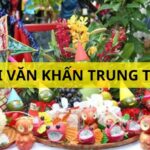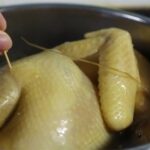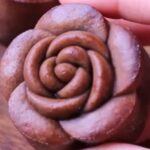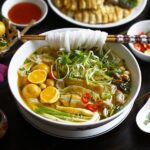Offering sacrifices on the first and fifteenth days of the lunar month has been a familiar tradition for Vietnamese people. Chicken is often an indispensable part of the salty offerings. However, the mid-autumn festival in August is a special full moon occasion.
Is it appropriate to offer chicken during the Mid-Autumn Festival?
The Mid-Autumn Festival in August usually combines the meanings of worshipping ancestors and the moon. Therefore, families often prepare two offerings: one for the ancestral altar and the other for the outdoor moon worship. Many families choose to prepare the offerings in the evening, finish worshipping their ancestors, gather for a meal, and then perform the moon worship ceremony outdoors.
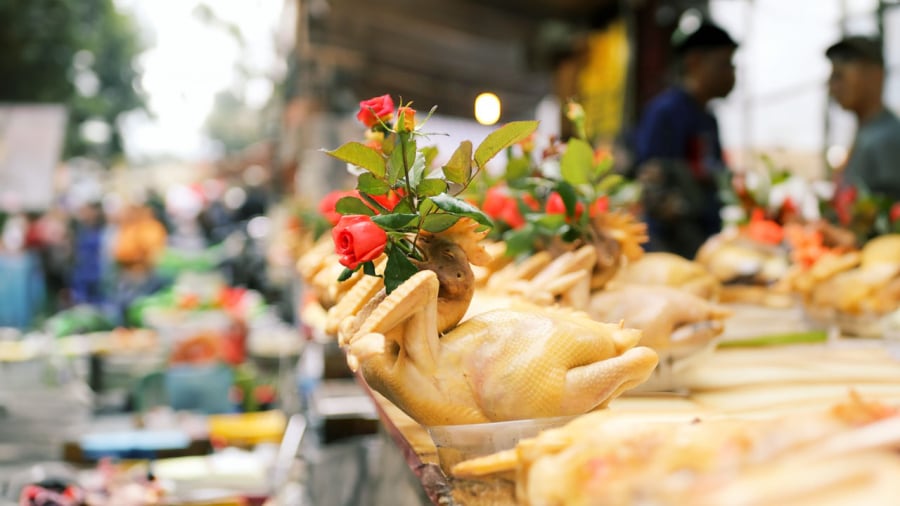
Chicken is still offered in the ancestral worship ceremony
The offerings for the ancestors vary depending on the family’s preference for vegetarian or non-vegetarian food. Families who practice vegetarianism will not include dishes like boiled chicken and pork but instead offer rice, fruit, and tea. On the other hand, non-vegetarian families typically include chicken, glutinous rice, sausages, fruit, betel, and tea in their ancestral offerings. Traditionally, a boiled rooster is chosen to symbolize solemnity and majesty. The rooster also represents the connection between the host and the deities, as well as their ancestors.
The outdoor moon worship ceremony usually involves offering autumn fruits, mooncakes, bananas, pomelos, custard apples, pomegranates, and pears. Specifically, bananas symbolize good luck, pomelos represent auspiciousness, pears represent abundance and prosperity, custard apples represent growth and development, and pomegranates represent blessings, luck, and fortune. These are also characteristic fruits of autumn. The mooncakes symbolize the moon or the concept of “round sky and square earth,” as well as the transformation of carp into dragons. To make the Mid-Autumn Festival offerings more vibrant, decorations such as dogs made from pomelos and other fruits, symbolizing the story of Cuoi and his loyal dog, are added, along with star-shaped lanterns and “keo quan” lanterns to ward off evil spirits. Traditional teas such as lotus tea and jasmine tea are also included.
The offerings for the moon festival are usually presented on a separate tray from the ancestral offerings. Typically, the Mid-Autumn Festival offerings can be presented outdoors or on a separate table, and the family gathers to enjoy the mooncakes and admire the moon after dinner.

Mid-Autumn Festival offerings typically include seasonal fruits and mooncakes
Notes on the Mid-Autumn Festival Worship
Since the Mid-Autumn Festival is about moon worship, it is usually held in the evening when the sun sets and the moon rises high in the sky.
As the moon is bright and clear during the Mid-Autumn Festival, people often spread mats, set up tables and chairs outdoors to enjoy the moonlight, believing that the moon’s radiance brings good luck and positive energy. However, it is advisable to avoid staying out too late, as the night chill may cause illness.
The elderly, young children, and those in poor health should refrain from going out late at night.
It is customary to light lanterns, carry “keo quan” lanterns, and participate in lantern processions during the Mid-Autumn Festival to bring good luck and ward off evil spirits.
Reference information for contemplation
“The Diverse Celebrations of the ‘Kitchen God’ Festival in Vietnam’s Three Regions”
“The tradition of worshipping the Kitchen Gods varies across the three regions of Vietnam, each with its own unique timing, offerings, and rituals. Let’s delve into the fascinating details of this ceremony as practiced in the North, Central, and Southern regions, and explore the rich cultural diversity of Vietnam during this auspicious occasion.”

























